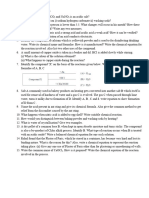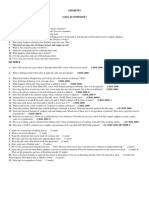0%(1)0% found this document useful (1 vote)
180 viewsAcid Base and Salts Work Sheet 2
Acid Base and Salts Work Sheet 2
Uploaded by
api-251783882Copyright:
© All Rights Reserved
Available Formats
Download as PDF, TXT or read online from Scribd
Acid Base and Salts Work Sheet 2
Acid Base and Salts Work Sheet 2
Uploaded by
api-2517838820%(1)0% found this document useful (1 vote)
180 views2 pagesOriginal Title
acid base and salts work sheet 2
Copyright
© © All Rights Reserved
Available Formats
PDF, TXT or read online from Scribd
Share this document
Did you find this document useful?
Is this content inappropriate?
Copyright:
© All Rights Reserved
Available Formats
Download as PDF, TXT or read online from Scribd
Download as pdf or txt
0%(1)0% found this document useful (1 vote)
180 views2 pagesAcid Base and Salts Work Sheet 2
Acid Base and Salts Work Sheet 2
Uploaded by
api-251783882Copyright:
© All Rights Reserved
Available Formats
Download as PDF, TXT or read online from Scribd
Download as pdf or txt
You are on page 1of 2
______________________________________________________
Class10 Acids, Bases and Salts Worksheet 2
1. How are the following salts called? Give one example each?
a. salts of sulphuric acid
b. salts of carbonic acid
c. salts of nitric acid
2. What would be the colour of methyl orange in the following solutions?
a. Calcium sulphate
b. Magnesium bicarbonate
c. Sodium hydroxide
d. Nitric acid
3. Suggest two bases which can be used to reduce acidity in the stomach.
4. Few pieces of zinc granules are added to 5 ml of sodium hydroxide
solution taken in a test tube and warmed. What would you observe?
Write the relevant chemical equation.
5. How does the use of toothpaste help in preventing tooth decay?
6. Metal oxides are usually insoluble in water but some of them dissolve to
form a basic solution. Name two such oxides. What is the name given to
the solutions of such oxides?
7. A student dropped few pieces of marble in dilute hydrochloric acid in a
test tube and passed the gas evolved through lime water. What change
would he observe in lime water? Write balanced equations for both the
changes involved.
8. Give reason:
a. Baking soda makes the cake soft and spongy
b. Baking soda is used in fire extinguisher
c. Baking soda is used as an antacid.
9. A calcium compound which is yellowish white powder is used as a
disinfectant and also in textile industry. Name the compound and write its
chemical name. Which gas is released when this compound is exposed to
air?
11. During the electrolysis of brine solution, which gas is liberated at?
a. anode
b. cathode.
Write the equation for the reaction taking place.
12. Give three practical applications of neutralization reaction.
13. Write equation for the reaction of sodium hydroxide with
a.CO
2
b.H
2
SO
4
14. Perishable food are preserved in vinegar. Why?
15. A metal carbonate on reacting with an acid gives a gas X which when
passed through a solution Y gives the carbonate back. On the other
hand, a gas (G) that is obtained at the anode during electrolysis of brine
is passed on dry Y, it gives a compound Z, used for disinfecting
drinking water. Identify X, Y, G and Z.
You might also like
- CBSE Class 10 Science HOTs Question BankDocument63 pagesCBSE Class 10 Science HOTs Question BankSobana Itharaji89% (9)
- Cl-7 (Ch3 and 4)Document4 pagesCl-7 (Ch3 and 4)Sureshkumar DevanNo ratings yet
- QPSolution CH 2 DT 03 06 2024 6320248192607Document4 pagesQPSolution CH 2 DT 03 06 2024 6320248192607james shahNo ratings yet
- Assignment Class 10Document2 pagesAssignment Class 10MerlinNo ratings yet
- Acid Bases and Salts Previous Year Questiosn Class 10 ScienceDocument5 pagesAcid Bases and Salts Previous Year Questiosn Class 10 Scienceclashhunting123123No ratings yet
- Chapter 1Document6 pagesChapter 1Sureshkumar DevanNo ratings yet
- Acid Bases and Salts Previous Year Questiosn Class 10 Science (8 Files Merged)Document47 pagesAcid Bases and Salts Previous Year Questiosn Class 10 Science (8 Files Merged)satyabrata sahooNo ratings yet
- CH2Document28 pagesCH2Nagi Reddy KovvuriNo ratings yet
- Asm 3498Document4 pagesAsm 3498balaNo ratings yet
- Acid Bases and Salts Previous Year Questiosn Class 10 ScienceDocument5 pagesAcid Bases and Salts Previous Year Questiosn Class 10 Sciencesatyabrata sahooNo ratings yet
- 6658 Books Doubtnut Question Bank - HTMLDocument21 pages6658 Books Doubtnut Question Bank - HTMLRaza Abbas0% (1)
- Revision Worksheet Chap-1 & 2Document6 pagesRevision Worksheet Chap-1 & 2chaurasiaishika66No ratings yet
- Ryan Internaional School, Mansarovar, Jaipur Revision Worksheet-Std X Acids, Bases and SaltsDocument38 pagesRyan Internaional School, Mansarovar, Jaipur Revision Worksheet-Std X Acids, Bases and SaltsPriti GoyalNo ratings yet
- Acid, Base & Salts Level ++Document4 pagesAcid, Base & Salts Level ++ayush.me.27No ratings yet
- Acid Bases and SaltsDocument7 pagesAcid Bases and SaltsSubhash suhasariaNo ratings yet
- Chapter 7 QuizDocument10 pagesChapter 7 QuizSuny100% (1)
- Class 10 Chapter 2 Science Important QuestionsDocument4 pagesClass 10 Chapter 2 Science Important QuestionsGhanendra100% (1)
- Ch-2 Practice WSDocument3 pagesCh-2 Practice WSJuwariyah NafeesNo ratings yet
- Class X Science Acids, Bases and Salts Worksheet 1 - 4Document2 pagesClass X Science Acids, Bases and Salts Worksheet 1 - 4krishnamoorthy kannanNo ratings yet
- Chapter 2 Acids, Bases and Salts Previous Year QuestionsDocument4 pagesChapter 2 Acids, Bases and Salts Previous Year Questionsjaiswaldesign99No ratings yet
- IMPORTANT QUESTION OF ACID BASES AND SALTS BY AMIT SIRDocument1 pageIMPORTANT QUESTION OF ACID BASES AND SALTS BY AMIT SIRankitza1007No ratings yet
- Chemical Reactions and Equations Assignment Session 2017 - 18Document3 pagesChemical Reactions and Equations Assignment Session 2017 - 18Aaryan PanchalNo ratings yet
- AKRWS - VII - Science - L-4 and L-5 - September - 2024-25Document4 pagesAKRWS - VII - Science - L-4 and L-5 - September - 2024-25dashmesh.bhatia.123No ratings yet
- Previous Year Questions Acids, Bases & SaltsDocument21 pagesPrevious Year Questions Acids, Bases & Saltskingbakugou067% (3)
- Asm 19294Document3 pagesAsm 19294shaureya13tsNo ratings yet
- Acids Bases and Salts PyqsDocument31 pagesAcids Bases and Salts PyqssundararajkvrajNo ratings yet
- Qns Acid Base and SaltsDocument24 pagesQns Acid Base and Saltsathipharma.78No ratings yet
- Chem Revision QuestionsDocument19 pagesChem Revision Questionsav10082009No ratings yet
- Ch-2+DescriptiveDocument2 pagesCh-2+DescriptivegeetasatyapriyaNo ratings yet
- Open Ch2acid10scDocument62 pagesOpen Ch2acid10scpayan6533No ratings yet
- Acids Bases & Salts: Short Answer Type Questions (L) (2 Marks) - Year 2015Document14 pagesAcids Bases & Salts: Short Answer Type Questions (L) (2 Marks) - Year 2015rajamohanNo ratings yet
- Cbse Test Paper 01 02 Acid Base and SaltDocument2 pagesCbse Test Paper 01 02 Acid Base and SaltDhaval PrabhuNo ratings yet
- Acid, Base & SaltDocument2 pagesAcid, Base & SaltShreyansh DuggarNo ratings yet
- Class-10 - Acid Base and Salt WorksheetDocument3 pagesClass-10 - Acid Base and Salt Worksheetakashsadoriya5477No ratings yet
- 13 Acids Bases and Salts Chapter Wise Important QuestionsDocument10 pages13 Acids Bases and Salts Chapter Wise Important QuestionsRakesh S DNo ratings yet
- QB Chap 2 WordDocument5 pagesQB Chap 2 WordSaravanna . B. K 8 C VVPNo ratings yet
- Document (1) (1)Document4 pagesDocument (1) (1)nishantsingh0724No ratings yet
- ChemistryDocument23 pagesChemistryktvenkatesha593No ratings yet
- Class 10 Science Most Repeated Questions in CBSE ExamsDocument50 pagesClass 10 Science Most Repeated Questions in CBSE Examsbrw5fp4chcNo ratings yet
- Cl-10 QB Le-2Document10 pagesCl-10 QB Le-2saicharanghantasala64No ratings yet
- Resource_20220823190123_chapter_2_previous_year_board_questionsDocument3 pagesResource_20220823190123_chapter_2_previous_year_board_questionshardikmakkar63No ratings yet
- Test Acids and BasesDocument2 pagesTest Acids and Basessatti376No ratings yet
- Extra Questions Class 10 Chap 2 (Sheet 1)Document2 pagesExtra Questions Class 10 Chap 2 (Sheet 1)47hr96m9d8No ratings yet
- Class X_physics_half Yearly Revision Worksheets_2024 25Document17 pagesClass X_physics_half Yearly Revision Worksheets_2024 25jhonnyraj254No ratings yet
- CBSE Class 10 Science - Acids Bases and SaltsDocument2 pagesCBSE Class 10 Science - Acids Bases and SaltsS K KUSHWAHANo ratings yet
- CBSE Class 10 Science - Acids Bases and SaltsDocument2 pagesCBSE Class 10 Science - Acids Bases and SaltsAnuska SaxenaNo ratings yet
- Test CH 2Document6 pagesTest CH 2Nagi Reddy KovvuriNo ratings yet
- Acids and Indicators - WorksheetDocument2 pagesAcids and Indicators - Worksheetlohitvarun10.mvmhydNo ratings yet
- 10 Years paper-WPS OfficeDocument6 pages10 Years paper-WPS Officeashutoshshraj123456No ratings yet
- Exam Questions PG 215 218Document30 pagesExam Questions PG 215 218mmathelommola346No ratings yet
- SRM Tutorials 10 Acid Base and Salt TestDocument2 pagesSRM Tutorials 10 Acid Base and Salt TestArsh GaurNo ratings yet
- Chemistry Class 10Document8 pagesChemistry Class 10Ruchika RastogiNo ratings yet
- Acid, Bases and Salts New WorksheetDocument4 pagesAcid, Bases and Salts New Worksheetrandheer.sws1925No ratings yet
- Class X Chemistry Worksheet RevisionDocument2 pagesClass X Chemistry Worksheet Revisionroh7.xsNo ratings yet
- Assignment-2 - Acid BaseDocument6 pagesAssignment-2 - Acid BaseJayadevi ShanmugamNo ratings yet
- ACIDS BASES SALTS ExerciseDocument13 pagesACIDS BASES SALTS ExerciseManmeetNo ratings yet
- Worksheet Chapter 1Document5 pagesWorksheet Chapter 1Amaan HaiderNo ratings yet
- Important Question For Class 10 Science Acids, Ba 6Document3 pagesImportant Question For Class 10 Science Acids, Ba 6istyrasttihgNo ratings yet
- Study Material Class 10 Chemistry Chap 2 2024-25Document6 pagesStudy Material Class 10 Chemistry Chap 2 2024-25akshitajashNo ratings yet



























































